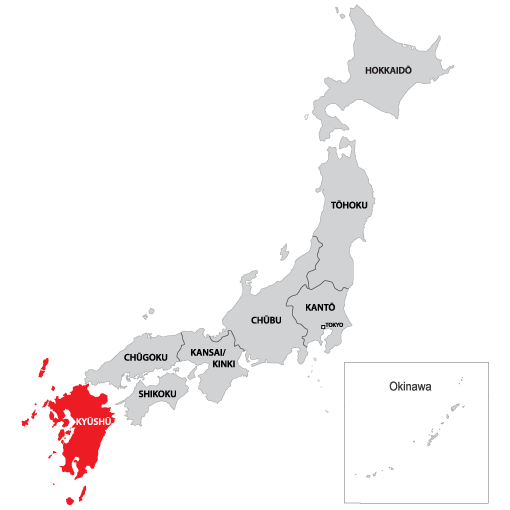
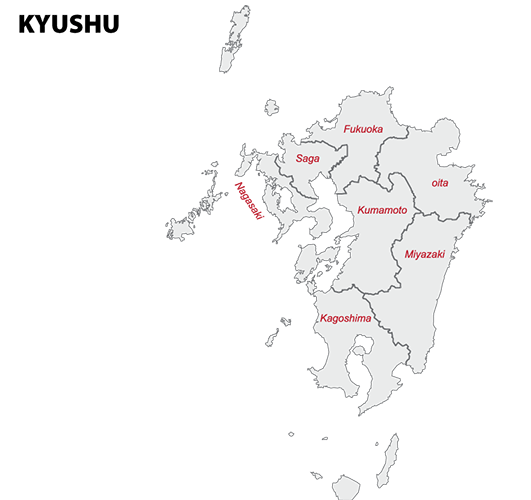
The third-largest island, Kyushu, which is located in the southwestern part of the country, takes its name from the nine regions that formed the area in the 8th century.
Now, the Island consists of seven prefectures Kyushu is the Westernmost of Japan’s four main islands, lying to the west of Honshu and separated from Honshu by the Kanmon Straits. Kyushu is bordered by the East China Sea to the west and the Pacific Ocean to the east. Its climate is mild and warm with a dynamic landscape of active volcanic peaks, lush mountains, and onsen hot springs everywhere surrounded by the blue and green shades of the ocean. The residents are lively and friendly. They also have a reputation for being happy drinkers who love a good party. Their characteristics of warmth and the sense of welcoming newcomers can be partially attributed to the warm climate, the dynamic landscape, and nature, as well as the long history of being a gateway for trade with other countries such as China and Korea.
Fukuoka Prefecture
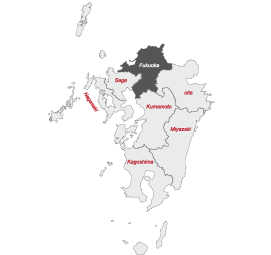 Fukuoka lies at the northern tip of Kyushu and is the largest prefecture in Kyushu. The gateway to Honshu is the vibrant metropolis, Hakata, and people they are called ‘Hakatakko’ and they are outspoken, individualistic, and very friendly. The city is known for being one of the best food scenes in Japan. One of the symbols of the city is its Yatai, fascinating open-air food strolls which trade only in the evening. The small food stalls are scattered across the city but you will find many of them in the Nakasu area along the water and you’ll see many locals drinking and enjoying a wide variety of dishes including famous Hakata ramen, grilled chicken skewers, and hotpot. Hakata ramen is so popular that many chains that originated in Fukuoka now have branches throughout Japan.
Fukuoka lies at the northern tip of Kyushu and is the largest prefecture in Kyushu. The gateway to Honshu is the vibrant metropolis, Hakata, and people they are called ‘Hakatakko’ and they are outspoken, individualistic, and very friendly. The city is known for being one of the best food scenes in Japan. One of the symbols of the city is its Yatai, fascinating open-air food strolls which trade only in the evening. The small food stalls are scattered across the city but you will find many of them in the Nakasu area along the water and you’ll see many locals drinking and enjoying a wide variety of dishes including famous Hakata ramen, grilled chicken skewers, and hotpot. Hakata ramen is so popular that many chains that originated in Fukuoka now have branches throughout Japan.
Fukuoka is a town of two halves. The downtown area around Tenjin and Hakata station, the Western end of the Tokaido Shinkansen or bullet train is a commercial center. Here you’ll find not just the city’s modern center with shopping and everyday conveniences, but also signs of Fukuoka’s traditions. The Kushida Shrine displays one of the floats for the lively Gion Yamakasa festival. The nearby Shofukuji Temple, the first Zen temple in Japan, is an illustration of how imported ideas often arrived in Fukuoka first. Ohori Park provides a bit of peace for city dwellers, but further opportunities for outdoor relaxation like by the sea, including the Fukuoka Tower, the Momochi Seaside Park, the Uminonakamichi Seaside Park, and Nokonoshima Island Park.
Dazaifu is one of the best-known sites and was established in the 7th century, located in the south of Fukuoka city. It was once the seat of the Yamago government for Kyushu and it was the center of defenses against incursions from nearby countries Korea and China. There are many temples and shrines in the area but the Dazaifu Tenmangu shrine, dedicated to Tenjin, the guardian deity of learning, is especially popular with numerous students during the examination period for their success in their exams. The Kyushu National Museum is also located in Dazaifu, near the Shrine.
There are other popular places to visit in Fukuoka Prefecture. Mojiko sits across the Kanmon straits from Shimonoseki and has been an international trading port since the late 19th century. Mojiko now has an atmosphere of both the Meiji and Taisho periods with well-preserved buildings of Western-style. Obsessed with Japan’s fantastic multi-featured toilets? You may wish to visit the Toto museum in Kitakyushu. In springtime, visitors flock to the Kawachi Wisteria Garden to walk through the long tunnels of hanging wisteria. Yanagawa, to the west of Fukuoka, is worth a visit and is known as Japan’s Venice. People can enjoy a traditional small boat ride going through the picturesque and nostalgic town.



Oita Prefecture
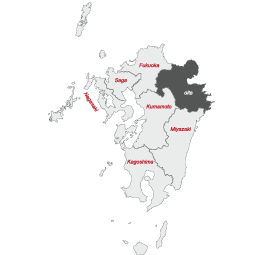 Oita Prefecture is located on the northeastern coast of Kyushu facing the Suo Sea and Bungo channel of the Pacific Ocean. Most of the interior is mountainous, and there are many amazing onsen hot springs. The yield of hot springs water is the largest in Japan, therefore, Oita calls itself the ‘Onsen Prefecture’.
Oita Prefecture is located on the northeastern coast of Kyushu facing the Suo Sea and Bungo channel of the Pacific Ocean. Most of the interior is mountainous, and there are many amazing onsen hot springs. The yield of hot springs water is the largest in Japan, therefore, Oita calls itself the ‘Onsen Prefecture’.
The most visited onsen destination in Oita is Beppu, which is one of the most well-known in Japan. Beppu has been a seaside resort for centuries and because it overflows with volcanic hot springs from beneath the surface, you will see plumes of hot water vapor venting up to the sky across the resort. There are two types of hot springs. The Jigoku or Hells are purely for visiting and admiring – not for bathing. A very popular attraction is the Jigoku meguri circuit, visiting the eight hell’s ponds including the “blood pond” and “tornado hell”, where waters bubble forth from underground. The other hot springs are at a more suitable temperature for bathing as usual and are the greatest pleasure for locals as well as tourists. Beppu also features other types of baths for the more adventurous, including sand baths where you will be buried in naturally heated sand, steam baths that are heated by the steam of a hot spring, and mud baths where bathers are covered with muddy hot water.
Yufuin is another popular onsen resort, close to Beppu about 25 km inland and it sits along the foot of the twin peaks of Mount Yufudake. The resort is atmospheric and there are traditional ryokan for refined guests. In the main street, you will find boutique restaurants, cafes, and craft shops leading to pleasant Kinrin-ko, the lake of golden fish scales.
Mount Yufudake (1584 m) symbolizes Yufuin, and it has been worshiped from ancient times. It is popular among mountain hikers or climbers and the panoramic views from the peak are breathtaking. It takes around two to three hours to reach the east peak but the west peak should be left for more experienced climbers. Yufuin is a good base for a day trip to Mount Yufudake and it is a delightful experience to soak in the onsen hot springs after a pleasant hike or climbing the mountain.



In Oita, there are numerous stone Buddha statues carved into the cliffs and rock faces all over the prefecture. They are found most especially on the Kunisaki Peninsula. The peninsula is located in the northern part of the prefecture and is characterized by a unique local religious culture, Rokugo Manzan. Rokugo Manzan has been a close part of local life for over 1,300 years. The faith is a mixture of Buddhism, Shintoism, and mountain worship. The hidden villages of the area are known for their peaceful farm life, lived out in harmony with the many ancient temples, shrines, and stone statues of Buddhas, deities, and guardians unique to the region. One of the best activities in the region is to hike the Kunisaki Long Trail. Its total length is about 135 km and the path is walked by mountain monks to achieve enlightenment. Following in the footsteps of the monks brings you closer to the heart of nature and Japan’s ancient history of Rokugo Manzan culture, and provides you with a unique experience possible nowhere else in the world.
The Kuju Mountain Range is located in Aso-Kuju National Park and includes the highest peak at Mt Nakadake. It is indeed one of the most spectacular regions in Kyushu. The area consists of about a dozen peaks among Japan’s 100 most famous mountains and offers magnificent volcanic terrain and dramatic landscapes. It is popular among outdoor enthusiasts for mountaineering but most of Kuju’s routes are beginner-friendly. Climbing such majestic volcanos is the perfect way to take your breath away and this volcanic region is dotted with onsen. At the foot of the mountains, there are ryokan and accommodations welcoming visitors to enjoy their baths for overnight stays as well as day visits.



Miyazaki Prefecture
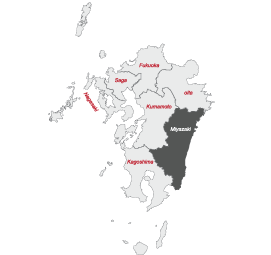 Heading south from Oita prefecture brings you to Miyazaki. Miyazaki prefecture lies on the southeastern coast of Kyushu and most of its cities are located along the coast. It is a subtropical region and the warm climate, beautiful coastlines, and good waves all year round make Miyazaki a great surfing destination. The prefecture also offers a variety of amazing local cuisine but Chicken Nanban and Hiyajiru are two of the most famous dishes to come from the area. The former is a deep-fried chicken, seasoned with sweet and sour soy sauce mixed with onions, and topped with tartar sauce. It has become one of the most popular fried chicken dishes in Japan. The latter is farmer’s food – cold rice with cucumbers and various ingredients including dried fish soaked in chilled miso soup. Hiyajiru is a great summer dish.
Heading south from Oita prefecture brings you to Miyazaki. Miyazaki prefecture lies on the southeastern coast of Kyushu and most of its cities are located along the coast. It is a subtropical region and the warm climate, beautiful coastlines, and good waves all year round make Miyazaki a great surfing destination. The prefecture also offers a variety of amazing local cuisine but Chicken Nanban and Hiyajiru are two of the most famous dishes to come from the area. The former is a deep-fried chicken, seasoned with sweet and sour soy sauce mixed with onions, and topped with tartar sauce. It has become one of the most popular fried chicken dishes in Japan. The latter is farmer’s food – cold rice with cucumbers and various ingredients including dried fish soaked in chilled miso soup. Hiyajiru is a great summer dish.
While the coast is characterized by beautiful ocean beaches, the inland of the prefecture is mountainous. Takachiho Gorge is probably one of the most well-known regions because of its stunning V-shaped gorge lined with sheer cliffs, created by volcanic eruptions. The gorge attracts visitors from all over Kyushu and the boat ride right through the heart of the gorge is breathtaking. From the water, viewing the spectacular Manai waterfall as it crashes from above, or seeing it drop into the gorge from the trail is a wonderful experience. The village also has many ties to Japanese folklore. A traditional Yokagura folk dance performance has been preserved by locals and is held every evening at the Kaguraden performance hall on the grounds of the Takachiho shrine.
The region is connected to the legend of Japanese folklore called Tenson Korin and it says that the goddess of the sun descended and made land on the top of Mount Takachiho-no-mine. Ancient Japanese mythology comes alive and people can feel the spirituality of the region. The nearby ‘power spot’ of Amano Yasugawara is said to be the spot where the sun goddess Amaterasu hid away from the turbulence and disruption created by her brother Susanoo, god of the sea. The remaining gods, frustrated with the darkness and storms, sought to tempt her out again with a banquet and entertainment at Gyobo cave. The area retains a sense of power. A shrine dedicated to Amaterasu, Amano Iwato Shrine, stands outside the caves.
South of Miyazaki on the Nichinan coast lies the island of Aoshima. The coastline around the island is characterized by unique sand and stone formations, known as the ‘devil’s washboard’. The island also has unique sub-tropical plants that can only be found here. The Aoshima Botanic Gardens showcases these. The island is also known as a power spot, and Aoshima Shrine is popular with young couples with its emphasis on love.
While the ocean and mountains of Miyazaki offer great natural beauty, the prefecture has deep links with Kyushu’s historical culture. Obi is a castle town located in Nichinan near the coast and it was originally ruled by the Shimazu Clan in Kagoshima but was later governed by the Ito Clan from the 16th century when it flourished. This quaint district is preserved well and is known as the little Kyoto of Kyushu. As you stroll through cobblestone streets, with shops and café, you will feel transported back to the Edo Period. Hidden away from the tropical coast, this authentic samurai town is reminiscent of old times. Also along the Nichinan coast is Udo Shrine set in a very unforgiving-looking cave. The shrine looks out onto rocky seas and the crash of the waves against the rock underscores the power of nature.



Saga Prefecture
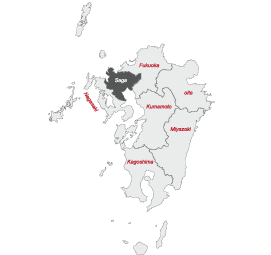 Saga prefecture occupies the northwestern corner of Kyushu between Fukuoka and Nagasaki prefecture and is famous throughout Japan for its pottery towns. Historically these towns have been pivotal to the pottery trade in Japan. There are three main pottery towns: Arita, Imari, and Karatsu. Arita is situated among the mountains and Imari is a port town nearby. The history of Arita ceramics dates back to the 17th century when Shogun Toyotomi Hideyoshi brought Korean craftsmen to Japan. Kaolin clay, an essential ingredient in the manufacture of porcelain, was discovered by one of the naturalized Korean potters, leading Arita to become the first in Japan to produce porcelain. Still today, you will see the chimneys of kilns standing tall in the town.
Saga prefecture occupies the northwestern corner of Kyushu between Fukuoka and Nagasaki prefecture and is famous throughout Japan for its pottery towns. Historically these towns have been pivotal to the pottery trade in Japan. There are three main pottery towns: Arita, Imari, and Karatsu. Arita is situated among the mountains and Imari is a port town nearby. The history of Arita ceramics dates back to the 17th century when Shogun Toyotomi Hideyoshi brought Korean craftsmen to Japan. Kaolin clay, an essential ingredient in the manufacture of porcelain, was discovered by one of the naturalized Korean potters, leading Arita to become the first in Japan to produce porcelain. Still today, you will see the chimneys of kilns standing tall in the town.
Imari ware and Arita ware were the same but came to be known abroad as Imari porcelain as they were exported from the port of Imari to Europe. Porcelain production soon became a major industry in the region, as Imari is an attractive multi-colored ware with blue and while and is sufficiently versatile for daily use. Karatsu lies in the northwest of Saga prefecture and faces the Genkai sea which once flourished as the gateway to China and Korea historically. This town is also a world-renowned pottery town, also with Korean influences, Karatsu ware was made from the late 16th century and has risen from pottery intended for daily use to ceramic art forms. The style of Karatsu ware is very different from Arita and Imari ware. It is a simple, generally iron clay body with an earthen-coloured glaze such as ash or feldspar-based glazes. Karatsu ware holds the spirituality of Japanese ‘Wabi’, traditional Japanese aesthetics, and the artists have developed their particular approach and sensibility in their aesthetics.
Saga prefecture is so well known for pottery that its other attractions often get overlooked, but the prefecture contains picturesque natural landscapes, mountains, and ocean as well as hot springs scattered throughout. It is refreshingly remote and typically well away from crowds of other tourists. The rice terraces of Hamanoura are a beautiful sight, particularly when they are lush and green in the summer with thriving plants. Ureshino Onsen and Takeo Onsen are both magnificent places to enjoy the ‘Land of Fire’ that is Kyushu. Both onsens have waters that are high in sodium bicarbonate, leaving bathers with silky feeling skin. Families traveling with children may wish to visit the Ninja Village Hizen Yumekaido, where they can dress like a ninja and learn some of their stealthy techniques. The prefecture’s Yoshinogari Park is an archeological site and open-air museum that brings to life the prehistoric peoples of the Yayoi period from 300 BC to 300 AD. The Yutoku Inari Shrine, one of the three exemplary Inari Shrines, is located in Saga prefecture near Kashima City and is just as impressive as Fushimi Inari and Taikodani Inari Shrine.



Nagasaki Prefecture
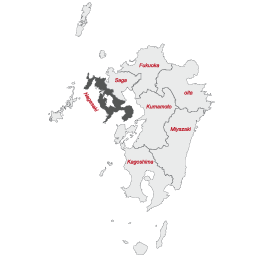 Nagasaki prefecture is located on the northwest coast of Kyushu. The prefecture borders Saga prefecture on the east and its western side faces the East China sea. The prefecture’s terrain is predominantly mountainous and it consists of the mainland, as well as the islands of Tsushima, Iki, and Hirado and those of the Goto archipelago which are dotted along the coastline. Nagasaki prospered as a gateway to other lands and countries and enjoyed early trade with the West, China, and Korea. Nagasaki subsequently became the conduit to Japan’s modernization and played an important role in creating unique blends of traditions from the cultures of these countries. The influences can still be seen today in various forms such as food, architecture, and festivals throughout the prefecture.
Nagasaki prefecture is located on the northwest coast of Kyushu. The prefecture borders Saga prefecture on the east and its western side faces the East China sea. The prefecture’s terrain is predominantly mountainous and it consists of the mainland, as well as the islands of Tsushima, Iki, and Hirado and those of the Goto archipelago which are dotted along the coastline. Nagasaki prospered as a gateway to other lands and countries and enjoyed early trade with the West, China, and Korea. Nagasaki subsequently became the conduit to Japan’s modernization and played an important role in creating unique blends of traditions from the cultures of these countries. The influences can still be seen today in various forms such as food, architecture, and festivals throughout the prefecture.
Rather uniquely to Japan, Nagasaki has a concentration of Christian believers. Nagasaki has a long history of receiving missionaries as a part of the foreign delegations. Christianity first came to Japan in the mid 16th century, at the hands of Catholic missionaries and St. Francis Xavier. Christianity flourished for a short period, but the Shogunate of Toyotomi Hideyoshi Shogunate introduced a ban on the religion in the late 16th century which continued for more than two centuries – only ending with the end of the isolationism of Japan and the Tokugawa Shogunate in the mid-19th century. Despite this, ‘Hidden Christians’ continued to practice their religion in secret despite its prohibition and some of them still prefer to remain in hiding even to this day.
The capital of Nagasaki prefecture is Nagasaki city and one of the most emotional places in Japan is Nagasaki Peace Park, built on a low hill north of the atomic bomb center as a prayer for world peace. The park commemorates the atomic bombing of the city – a catastrophic event causing the death of approximately 75,000 people on August 9th, 1945. Today, the park is a major destination for visitors both domestically and internationally. The focus of the park is on the 9.7m Peace Statue set to the north of the hypocenter of the atomic bomb blast which symbolizes the wish for peace.



A few kilometers away from the Peace Park, is a man-made small island, Dejima, in the port of Nagasaki. The island was built in the 17th century to segregate Christian Portuguese traders from the Japanese population but it subsequently became the Dutch trading post until the mid-19th century. It flourished with foreign trade and exchange during the Edo period but today, it is a small tourist destination containing a unique blend of Dutch influence and traditional Japanese style in the buildings and infrastructure. There are other sites in Nagasaki City that reflect foreign influences such as the Glover Garden and house that belonged to the Scottish industrialist. Urakami Cathedral and Oura Church are not the only buildings to show religious diversity – Sofukuji Temple with its Chinese-influenced architecture, and the Confucian Shrine illustrate the spread of influence from nearer neighbors. The city still has a bustling and lively Chinatown.
Gunkanjima Island or ‘Battleship Island’ has attracted greater attention following its appearance in Hollywood blockbuster films. The island lies about 4.5km west of the Nagasaki Peninsula. It once flourished as Japan’s first major undersea coal mine, operated by the Mitsubishi Corporation from the late 19th century. Their employees and families lived on the isolated island and at its peak in the mid-twentieth century, the island recorded more than five thousand residents. However, the exploitation ended in 1974 and the island was abandoned. For many years, access to the island was prohibited. Since the ban was lifted in 2009, the island’s contribution to the modernization of Japan has been recognized. The growing interest in the importance of the island and general curiosity about the island have increased the popularity of boat tours to the island and these now operate twice a day.
One of the most visited hot spring resort towns in Nagasaki prefecture is Unzen, located around the center of the Shimabara Peninsula, in the southeastern region of the prefecture. It is near the peak of Mount Unzen and a good base to explore the trails. Unzen Jigoku, also known as Unzen Hell, is an area of geothermal fields with over 30 ponds in the barren rocky area and you can walk the paved trail leading to steam vents, intense volcanic activity ponds, and mud holes along the way. In the early 17th century, Christians were tortured to death in the hot springs and this dark incident represents hell to some extent. While you will see a monument beside the Jigoku to commemorate the martyr now, it is a lovely destination for holidaymakers to enjoy its natural beauty, seasonal sweeps of color as well as onsen paradise.
Hirado Island, which lies at the end of the northwestern part of the prefecture, was the first Japanese port opened to the Portuguese. After St. Francis Xavier arrived with a Portuguese ship in 1550, the missionary began spreading the religion. Also, Portuguese and Japanese merchants commenced foreign trading, and Hirado Harbor developed as a bustling trading town. As Christianity’s influence grew. The Tokugawa Shogunate expelled the missionaries and banned the religion in the early 17th century which lasted for more than two centuries. Some of these “Hidden Christians” continued practicing Christianity in secret until the Meiji restoration in the late 19th century and restrictions on Christianity were lifted by the government. Even now, the blend of Western and Japanese culture is still alive in Hirado and you can discover this unique history and culture on the island while enjoying the beautiful scenery along the coast.
To the very west of Nagasaki, and the westernmost edge of Kyushu, the Goto Islands sit on the East China Sea, approximately 100km off the coast. Because of their remoteness, the five islands were a safe place for the Hidden Christians in the Edo period. Even now dozens of churches are scattered across the islands. Goto is known for having some of the most beautiful beaches in Japan but despite this, it is not a major destination. The incredibly beautiful white-silver sands are surrounded by emerald green waters that have not been seen even by many Japanese. Some say that the historical inhabitants preferred not to draw much attention to themselves from outside – perhaps they wished to keep the beauty of their home islands hidden.



Kumamoto Prefecture
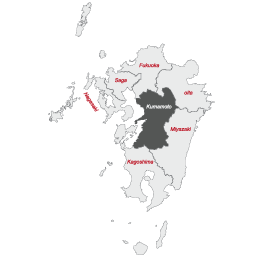 Kumamoto Prefecture is located in the center of Kyushu along the west coast and its capital is Kumamoto city. The city’s iconic and impressive Kumamoto Castle was damaged by a devastating earthquake in 2016, but after extensive repairs, some areas were reopened to the public in 2019. The reconstruction is still ongoing and is expected to be complete by the end of 2021.
Kumamoto Prefecture is located in the center of Kyushu along the west coast and its capital is Kumamoto city. The city’s iconic and impressive Kumamoto Castle was damaged by a devastating earthquake in 2016, but after extensive repairs, some areas were reopened to the public in 2019. The reconstruction is still ongoing and is expected to be complete by the end of 2021.
East of Kumamoto city lies Aso, a vast and active volcanic caldera. It is the largest in Japan and a popular destination for tourists. Several hundred thousand years of volcanic activity have resulted in today’s stunning shape, stretching 18 km from east to west, and 25 km from north to south. The caldera is about 23,000 hectares with grasslands and forests, and on the lowlands of Mount Aso, there are peaceful rural villages with vast agricultural plains and farmlands. Eruptions are fairly regular, but when conditions are safe, walking the network of Aso trails with the majestic scenery is an incredible experience for adventure travelers. Aso Shrine lies on the north side of Mount Aso in the town of Ichinomiya of Aso City, is the most important Shinto Shrine in the region and its origin is believed to date back around 2,500 years ago. The lineage of the Aso Lords and Aso Shrine can be traced back to twelve deities beginning with Takeiwatatsu-no-mikoto, enshrined here. He is said to be the grandchild of the first Emperor Jimmu of Japan, who himself was considered to be a descendant of the Goddess of the sun in Japanese mythology. The main gate and hall of the shrine collapsed in the earthquake in 2016 but the shrine is still open for visitors and festivals take place throughout the year. The restoration will be costly, estimated at over 20 billion yen, and is expected to take more than 10 years.
Kurokawa Onsen sits to the north of Aso along a crystal-clear river and has a quaint and traditional air. Kyushu has an abundance of natural hot springs but Kurokawa differs from most as it is a small village in a pristine setting and the onsen resort is known for being a rustic hidden gem with traditional row-rise buildings. The local community made a concerted effort over the years to preserve the village and they view the whole village holistically as one whole accommodation surrounded by a beautiful natural environment. There are pretty cafés, shops, and some of the most beautiful onsen accommodations in Kyushu. There are several hiking trails available which you can enjoy between onsen dips.



Kagoshima Prefecture
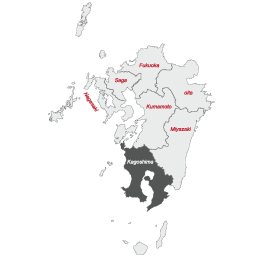 Kagoshima prefecture lies at the southern end of Kyushu and includes a further chain of tropical and subtropical islands stretching to the southwest of Kyushu hundreds of kilometers into the East China sea. The coastline of Kagoshima Bay is long and narrow, and one of Kagoshima’s most prominent features is its volcanic activity.
Kagoshima prefecture lies at the southern end of Kyushu and includes a further chain of tropical and subtropical islands stretching to the southwest of Kyushu hundreds of kilometers into the East China sea. The coastline of Kagoshima Bay is long and narrow, and one of Kagoshima’s most prominent features is its volcanic activity.
The landmark of Kagoshima city is Sakurajima Island, a 1,117 meter high smoldering volcanic island sitting just off the coast. Minor eruptions take place a few times a day and its silhouette topped with blackish ash is spectacular. Sakurajima is one of the most popular attractions to visit in Kagoshima and it is inhabited by more than 4,000 residents. It is easily accessed by a short ferry ride from Kagoshima Harbor. Public buses run regularly taking visitors to outlook points around the island where you can get a closer look at the volcano and possibly witness one of the smaller eruptions.
Kagoshima enjoys mild winters owing to its humid subtropical climate and it rarely snows in winter. Kagoshima is famed for its culinary traditions and local foods, known as Satsuma Cuisine (Satsuma was the former name of the Kagoshima area), and offers an array of distinct ingredients and flavors. One of the most popular foods is the Satsuma Age or deep-fried fish cake, made of minced fish with various fillings from carrots to peas, to scallops and prawns. Despite being deep-fried, the fish cakes do not become crispy but turn golden brown outside while remaining white and flavorful inside. Another popular food is Kurobuta, literally meaning black pork, named for the color of their hide. Kurobuta is often eaten as tonkatsu (breaded, deep-fried pork cutlet) or shabu shabu (hotpot of thinly sliced meat). There are other specialties such as Kibinago, a small flying fish commonly eaten raw, and chicken sashimi accompanied by ground ginger and soy sauce that is very freshly served raw. Each of these specialties is delicious and all are widely known in Japan. They are best sampled with Satsuma Shochu, a distilled spirit made from local sweet potatoes (Satsumaimo) that makes it easy to pair with all of the cuisines. Satsuma Shochu has a higher alcohol content of around 25% and is often mixed with cold or hot water rather than enjoyed straight. In Japan, Sake is probably the best-known alcohol in the nation and is made from rice, but in Kagoshima, rice cannot be grown because volcanic ash and pumice continuously drop on the ground. Sweet potatoes, however, one of the top products in the prefecture, thrive in these conditions. There are many varieties of shochu available from the shops and restaurants and Kagoshima natives are fiercely proud of Satsuma shochu.



Senganen is a Japanese-style landscape garden situated near the ferry terminal to Sakurajima, on the coast near the center of Kagoshima city. The garden was constructed in the mid-17th century by the Shimadzu clan, the most powerful of those to rule the Satsuma domain in the Edo period. Senganen covers 50,000 square meters against a stunning backdrop – the view of Sakurajima and Kagoshima bay. The garden includes small ponds, bamboo groves, and an expansive villa, which provides a glimpse into the lifestyle of the Shimadzu clan. The trail at the back of the garden leads up to the forest, and a short 20-minute ascent on foot is rewarded with the best view of Sakurajima and Kagoshima Bay.
Kirishima is located in the north-eastern part of Kagoshima Prefecture and is famed for its sulfur hot springs valleys and an active volcanic mountain range with abundant nature. There are a series of hiking trails through the mountains, highlands, and along the volcanic crater lakes. The region is linked with Japanese mythology and is referred to as the land where gods once descended to earth. It is said that the deity Ninigi-no-Mikoto, grandson of the sun goddess Amaterasu, descended from heaven to nearby the peak of sacred Mount Takachiho to rule over the earth and establish the lineage of Japanese Emperors. The most significant shrine in Kirishima is the Kirishima Grand Shrine, built in the 6th century, which honors the deity from the creation myth of Japan. The shrine was originally built at the foot of Mount Takachiho, but after being burnt down repeatedly as a result of volcanic eruptions, it was relocated to the present location. Nestled on the lower slope of the Kirishima mountain range, Kirishima onsen is one of the most popular hot springs resorts with 11 different kinds of high-quality hot spring waters. This onsen area has 300 years of history and there are well-established Japanese traditional onsen accommodations in the resort. Soaking high above sea level, you can admire the panoramic scenery of the Kirishima mountain range and Sakurajima floating in the Bay
At the southern tip of the Satsuma Peninsula in Kagoshima, Ibusuki is a popular seaside onsen resort that lies 1 to 1.5 hours by train from Kagoshima city. The unique feature of Ibusuki is its hot sand baths where bathers are buried up to the neck with sand by staff while lying under colorful parasols. You will see people buried in the hot sand. Never fear, the burial is only temporary! They will dig you out after your body is gradually warmed by the geothermal heat after 10-20 minutes. Sand bathing affords a unique sensation, one that is comfortable, refreshing, and relaxing. The waters have a high sodium content and are considered a good cure for rheumatism, neuralgia, female disorders, and digestive problems. After bathing, you will take a shower to rinse off the sand and then enjoy the more usual onsen hot springs inside the bathhouse for extra relaxation.



Yakushima is a natural paradise of remote wilderness. This secluded island is located 60km (37 miles) to the south of the southernmost tip of the mainland Kagoshima and its 130 km (80 miles) circumference consists of natural forest, up to 96% of which consists of untouched ancient cedar forests. Most of the island is mountainous with mountains over 1000 meters high, including Mount Miyanoura, which is the highest at 1,936 meters. The island was the first site in Japan inscribed on the UNESCO World Heritage List in 1993 because of its biodiversity and unique ecosystem with a climate ranging from subtropical to cool-temperate. Yakushima Island receives a lot of rain throughout the year, and the annual rainfall is more than double the rainfall of mainland Japan. This makes the island misty and mysterious, attracting avid hikers who have placed the island on their ‘must hike’ list. The island is home to 1,000-year-old trees that are its claim to fame, but there is more to Yakushima than trees. There are beautiful beaches which are perfect for snorkeling and watching sea turtles in summer.
One of the most unspoiled but accessible moss-covered canyons is the Shiratani Unsuikyo Ravine, spanning 424 hectares and home to some of the island’s ancient cedar trees that inspired Miyazaki Hayao’s Studio Ghibli animation, Princess Mononoke. The network of trails takes you past an array of ancient cedar trees and beautiful gorges. Even the less strenuous walking route is an incredibly captivating destination to walk through, with such old and majestic greenery and large ancient trees. Another popular cedar tree paradise is Yakusugi Land, covering an area of 270 hectares. There are a series of well-maintained trails, both short and long, with ancient cedar trees. Included amongst these is the Buddha cedar (Japanese cedar) which is said to be 1,800 years old. Similar to Shiratani Unsuikyo, the forests are covered with deep moss throughout, creating magnificent scenery unique to the island. Just a short 15-minute drive from Yakusugi Land brings you to the 3,000 years old Kigensugi, one of the giant cedars on the island,
The Jomonsugi is the oldest and largest Japanese cypress and it is said that the tree is from 3,000 to 7,200 years old. It is the main attraction of the island. Jomonsugi is often seen as the icon of Yakushima and many people complete a 10-hour hike on the Arakawa trail, starting before dawn and returning just before sunset to see this ancient tree. Along the trail, you can see other amazing trees including the Meotosugi, a pair of trees that look like a husband and wife holding hands with each other, and Wilson’s Stump, the remains of the tallest tree to have existed in Yakushima (approximately 44 meters) but now just a huge stump of this cedar tree to remain.
Yakushima is renowned for its ancient forests but the island is also blessed with some different hot springs. Hirauchi Kaichu Onsen, with 400 years of history, is an unmanned hot spring located on the southern coastline in a small hamlet. It is a unique onsen formed from rocks in the ocean. People can bathe in the rock pools at low tide, twice a day, a couple of hours before and after low tide, and in the middle of the ocean at other times. It is truly a unique experience bathing in a natural onsen and seeing the waves breaking nearby.



